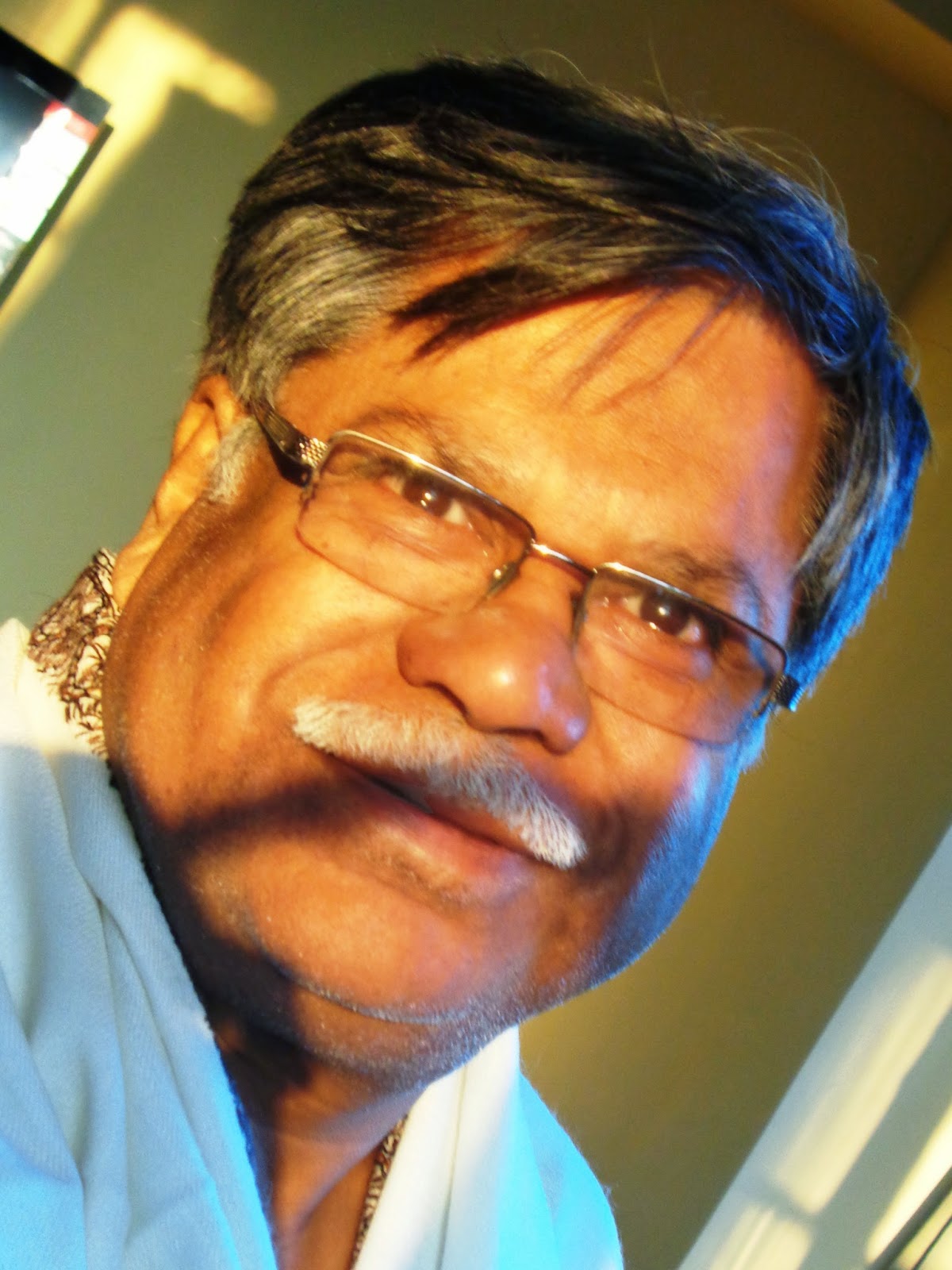In the first article of the present series ‘Andoloni Bangali: A Culture, An Identity and A Perception’ Sanat Mukhopadhyay reminisces those days of turbulent 60s and 70s when a peasant rebellion in Naxalbari of North Bengal ushered dreams of revolution in millions of young minds. West Bengal witnessed an armed uprising on the lines of China, Bolivia, Vietnam and Algeria. He also looked at this revolutionary ebullience with the ingrained romanticism within the Bengali self; thus the article is aptly named as ‘Looking back at the Late Sixties: Those days of ‘Spring Thunder’.
Looking back at the Late Sixties: Those days of ‘Spring Thunder’
Looking back at the Late Sixties: Those days of ‘Spring Thunder’
Written By
Sanat Mukhopadhyay
Sanat Mukhopadhyay
Translated by
Amitabha Bhattacharya
Amitabha Bhattacharya
It
all started in the late sixties – nearly a good fifty years ago. All of a
sudden strong winds of political change had started to blow within the compound
walls of our school. We were probably in standard ten or eleven. Our
impressionable minds became charged with the onus of deciding; exactly what
kind of revolution would be suitable for India- Bourgeois Democratic, Socialist
or New Democratic form of change?
Out
in the streets for the first time our eyes witnessed the graffiti on the walls
proclaiming ‘Chiner Chairman, amader
chairman’ (China’s Chairman is our Chairman), ‘Srikakulam path dekhabe’( Srikakulam will show the way) , ‘Gram die sohor ghero’ (Barricade the
cities with villages),’Khatam abhijan
cholche cholbe’ (annihilation will continue ). Our political theorist
‘dadas’ were out to convince us that India was a semi-feudal, semi-colonist
nation. Therefore, ideological conflict was but a natural corollary.
Figure
1: China's Chairman is Our Chairman
(Source:
indiatoday.intoday.in)
Extreme Ways: A New
Development in Post-Independence Politics :
Before
this, insurgency for us had meant the nationalist armed struggle carried on by
the likes of Shahid Khudiram in the pages of our history books. But now we got familiar
with a new kind of insurrection. In no time we got to see ‘action’ in the
streets of Calcutta. Charismatic radical leaders like Asim Chatterjee, Saroj
Dutta among others started frequenting various North Calcutta schools to stage
meetings. For the first time we were told that in a primarily agrarian India
only an armed peasant uprising can bring a meaningful social change. However,
the atmosphere at these meetings was such that there was not much scope for
engaging the speakers into answering ‘what would be the change and in what way
these changes would be brought about.’ Most of the time we would listen
intently, getting somewhat inspired too on occasions by these strongly put
across contentions.
Those
days the politically inclined in Bagbazar were clearly divided into two camps-
the progressives and the reactionaries. Those who had rejected what the
Naxalbari uprising stood for were of course the reactionaries. The relevant
slogan was ‘Cannon blast the headquarters of the reactionaries.’
Figure
2: 'Red Book'
(Source:
www.thegospelcoalition.org)
One
day a friend of ours brought a pocket edition of Mao Zedong’s ‘Red Book’! It
was a revelation. Each word and phase of that tiny book seemed packed with all
that was important to stage an armed struggle; absolutely incendiary material!
After a few hasty readings we were convinced that if anyone had not read this book; his or her life was indeed quite meaningless. We were told that it was the ‘Gita’of the proletariat.
Those
were turbulent times in Bengal- the tumultuous 60’s and 70’s. There was a
tremendous sense of excitement and expectancy in the air at schools and colleges, verging on what now; in retrospect seem like a fine madness. Thousands of
posters were up all over the city inciting people to destroy the Bourgeois
education system. We had a teacher in our school openly supporting the Naxalite
movement- he used to explain during his classes how armed peasant struggle was
changing the crux of our economy. From him we heard for the first time the term
‘Muktanchal’ (Liberated Base Areas)
which were zones under communist control which were practically beyond the
grasp of the state.
It
is my personal opinion that the more radical political factions in Bengal
started to think anew along the lines of armed struggle from the time of the
Chinese aggression of 1962-64. After nearly total disillusionment with post
independent politics for about twenty years, there was a desperate bid to break
free which only pulled the state into a deadly vortex of broken dreams, revolution,
counter revolution and self destruction. The youth of Bengal had believed that
whatever was happening in China, Vietnam, Algeria, Bolivia, was; but the
immediate future of India. They thought revolution and that sweet word liberty
was at an arm’s reach and the collapse of the state was imminent. It was as if
everyone was in a strange state of denial in their bid to usher in a better
tomorrow.
Figure
3: Trams were burnt (4th September, 1962)
(Source:
http://www.openthemagazine.com/article/nation/bloodied-bengal-and-its-bhadralok)
Amidst
all these a new kind of conflict ridden party politics was emerging – quite
different from the hitherto prevailing political scenario. The specter of
political violence cast its long shadow over the state. The long line of deaths
began at Naxalbari. In no time Calcutta was reeling under a spate of brutal,
mindless and seemingly endless political killings.
(Source:left- www.goodreads.com, right- www.amazon.com)
The
Naxalbari uprising had created a new class of intellectuals who diligently read
‘The Red Book’, ‘Che Guevara’s Diaries’ and Liu Shao Chi’s ‘How to be a good
Communist’. However, the diaspora of
extremist politics was fractious to say the least. There were endless arguments
regarding adopting the programme, strategy and tactics concerning the burning
issues of the day. Hair splitting arguments took place about the revisionist
and neo-revisionist lines adopted by different leftist parties in an effort to
avoid conflict with the state.
The Division Bell:
Source: www.cpiml.tk
There
was immense ideological pride and ensuing intractability among the theorists
and party ideologues which quickly degenerated into very serious differences
between the leftists. The Naxalites’ call for boycotting the general elections
led to full-fledged antagonism between the CPI (M) and the CPI (ML). The noted
thespian Utpal Dutta had supported the Naxalites over a few issues for which he
was severely censured in ‘Ganasakti’, the CPM ran Bengal daily. A schism ran
wide within the CPM and overnight a number of renowned comrades, high up in the
party hierarchy were expelled. The entire state got divided into CPM and CPI (ML)
zones. It was a terrible time. CPI (ML) took up their dreaded ‘annihilation
line’. No one was safe from this deadly hit-list- whether one was a constable
or a poverty ridden youth. The armed uprising which began in a bloody peasant
police face off at Naxalbari had now turned into a fratricidal carnage between
leftist parties. None of us had a clue as to where all this mindless violence
was taking us. Two new words were doing the rounds everywhere- ‘Combing’ and
‘Encounter’. The city walls bore testimony to the new frontiers of the peasant
upheaval. Debra, Gopiballavpur, Khusahari,Kheri,Srikakulam,Lakhimpur no longer
remained barely known sleepy hamlets in the middle of nowhere.
Figure
4: Leaders in Meeting
(Source:
epaper.timesofindia.com)
One
day a chance meeting with a neighbour; Mr. Shanti Roy had him confide in me that
he has gone ‘underground’- another word which had become part and parcel with
the select vocabulary of those troubled times and with which we would grow
progressively familiar with each passing day. Police squads were moving from
hospital to hospital on the lookout for youth belonging to the ‘action squads’.
As a result the hunted often adopted extreme measures to avoid the dragnet and
in one case someone spent an entire night lying next to corpses in a ‘morgue’.
The
young far-leftists often talked about Comrade Charu Majumdar’s ‘Historic Eight
Documents’ which formed the basis of the Naxalite ideology. They also said that
Mao Zedong’s brand of communism was Marxism Leninism reinterpreted for the
changed times. Wall posters were claiming as strongly as ever: ‘China’s way is
our way’, ‘Annihilate the class enemy with guerilla warfare.’ The Naxal
movement had indeed given birth to the politics of violence. Many of the
students those days had a copy of ‘Deshodrohi’ the Bengali organ of CPI (ML).
As a reaction ‘Ganasakti’ came out strongly against the writings of Saroj
Dutta, Kanu Sanyal and Charu Majumdar in its columns. We were too overwhelmed
to realize if all the emerging anger, hatred and violence was a true reflection
of the Bengali tradition of protest.
Very
soon though, the state machinery came down very heavily upon the Maoist
guerillas. It became apparent that the state administration was no ‘paper
tiger’. The bid to rout the Naxalites was massive, ruthless and relentless.
Besides the ‘annihilation line’ had alienated the far-left from the masses. The
youth, specially the college students, moved away from violent subversion to a more democratic and peaceful mode of protest. In the end the Naxalite movement
failed to give a meaningful direction to the politics of the day.
Concluding note:
Now,
even after all these years when I look back with a faint sense of bewilderment,
if not in anger at our society, I feel there is something inherent in the
Bengali character which is against the establishment. What began as a protest
against economic exploitation with an agricultural background at Naxalbari
spread to the metropolis of Calcutta with its students and intellectuals and
finally took the shape of an anti-establishment agitation.
Again,
the college going Bengali is a die-hard romantic who indulges in a never ending
romance with the revolution. Even after so many years, the days of ‘spring
thunder’ seem to beckon many old naxalites in their dreams.
I
would like to conclude by saying that over the years; the Bengali psyche, under
the influence of intelligentsia as diverse as Raja Ram Mohan Roy to Charu Majumdar
has evolved and progressed. The ingrained aspect of protest in the Bengali
character has transcended its many inconsistencies and contradictions to
interpret the changing times after its own fashion. At times it has most audaciously had even attempted to seemingly change the course of line with an iron fist.
However, in the end, time prevails over all. Our journey too thus, never really
ends!
(This
article is originally written in Bengali by Sanat Mukhopadhyay)
Abbreviation:
CPI (M)-Communist Party of India, Marxist. CPI (ML) – Communist Party of India,
Marxist and Leninist
Author’s
Bio Note:
Sanat
Mukhopadhyay was born on 17 October, 1955 at Bagbazar area of North Kolkata. He
has done his masters from Calcutta University in Bengali literature. By
profession he is a teacher. Currently he is teacher-in-charge in Saradacharan
Aryan Institution. He writes in magazines from his college days. His book ‘Kiran Chandra
Dutta O Tatkalin Samaj’ is a research based work.



.bmp)




1. The Bengali organ of CPI(ML) was 'Deshobroti' not 'Deshodrohi'.
ReplyDelete2. The book written by the author, mentioned in authors bio - note is co-authored with Manju Dutta.
- As per author's request.